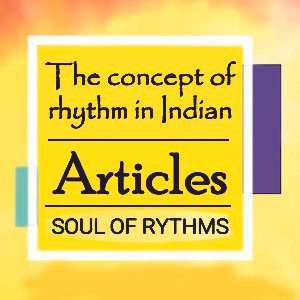In today's article we will discuss about "The concept of rhythm in Indian Music". In India, music has been associated with the period of time. It is believed that the Gods were the first to give birth to music and musical instruments with many deities are also added. Damro to Shiva, Pakhawaj to Ganesh, Veena to mother Saraswati, Flute to Shri Krishna, etc. In India, music is seen in metaphysics, perhaps because of which honor is given to music and musical instruments in India. it can not be found anywhere else in the whole world.
In ancient musical texts, music is given only for singing, playing and Dancing . The smallest unit of measuring time in the Indian music period is Matra or Beat. The rhythm is formed from the group of Matras or Beats. The rhythm is the cornerstone of music in which it attains its original purpose. It has been said in the context of Taal that 'T' was created by Tandava Dance of Lord Shiva's and 'L' was created from the Lasya Dance of Parvati.
According to Ancient Musical text Sageet Makrand, the continent, which is a recurring period of time, which holds the fountain of the song, instrumental and dance on itself, is called the rhythm.
Based on the rhythm, it is a process that provides a proper and meaningful form to any musical Composition. Just as the threaded pearl in a garland looks beautiful after clinging together in one's lanyard. The music (singing, playing, Dancing) merged in rhythm looks also meaningful and beautiful.
Indian musical texts have recorded 10 lives of rhythm – Time or Duration, Path, Action, Grouping, Position, Type or Classification, Number of Sound Syllables in a Matra or Beat, Time Progression, Yati(Change in Speed) and Prastar(The way you improvise a rhythm) . (Refer this link for Taal ke 10 Praan).
So this is a small idea of the this concept "The concept of rhythm in Indian Music" that how it works. Hope you like it. Please do share your words with us on "info@learntablaonline.com".

(भारतीय संगीत में ताल की अवधारणा)
भारत में संगीत को देव काल से जोड़ा जाता रहा है | ऐसा माना जाता है की सर्वप्रथम देवताओं ने ही संगीत को जनम दिया और कई देवताओं के साथ संगीत वाद्यों को भी जोड़ा जाता है ; शिव जी को डमरू, गणेश को पखावज, माँ सरस्वती को वीणा, श्री कृष्ण को बांसुरी, आदि | भारत में संगीत को अधयात्म से मिला कर देखा जाता है, शायद इसीलिए जितना मान-सम्मान भारत में संगीत और संगीत वाद्यों को दिया जाता है वो पूरे विश्व में कहीं और नहीं मिलता |
प्राचीन संगीत ग्रंथों में गायन, वादन और निर्त्य को ही संगीत की परिभाषा दी जाती है | भारतीय संगीत में काल अर्थात समय को मापने की सबसे छोटी इकाई मात्रा है तथा मात्राओं के समूह से ताल का निर्माण होता है | ताल संगीत में बंदिश की आधारशिला है जिसको धारण कर वह अपने मूल उद्देश्य को प्राप्त करती है | ताल शब्द के विषय में ऐसा कहा गया है कि भगवान शिव के तांडव से ‘त’ और पारवती के लास्य निर्त्य से ‘ल’ की उत्पति हुई |
संगीत मकरंद के अनुसार काल का आवर्तित होने वाला वह खंड जो गीत, वाद्य तथा निर्त्य को अपने ऊपर धारण करता है, ताल कहलाता है |
ताल लय के आधार पर रची वह प्रक्रिया है जो किसी सांगीतिक धुनी को उसका सही और सार्थक रूप प्रदान करती है | जिस प्रकार एक माला में पिरोये हुए मोती अपनी डोरी में एक साथ बंधने के बाद सुंदर लगते है ठीक वैसे ही ताल में बंधा हुआ संगीत(गायन, वादन,निर्त्य) भी सार्थक व सुंदर लगता है |
भारतीय संगीत ग्रंथों में ताल के १० प्राण दर्ज किये गये है- काल, मार्ग, क्रिया, अंग, ग्रह, जाति, कला, लय, यति ओर प्रस्तार |(ताल के 10 प्राणों की जानकारी हेतु यहाँ क्लिक करें|)
You must be logged in to post a comment.